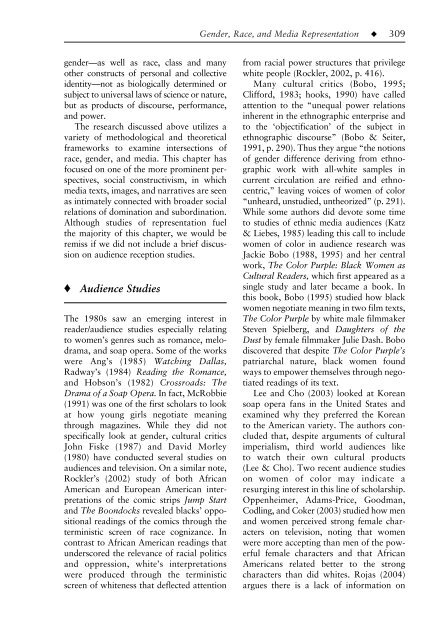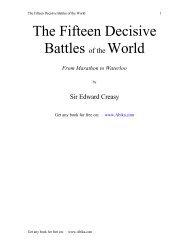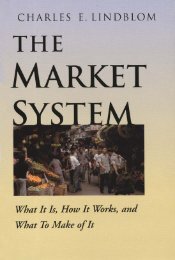Gender, race, and media representation - afghan
Gender, race, and media representation - afghan
Gender, race, and media representation - afghan
You also want an ePaper? Increase the reach of your titles
YUMPU automatically turns print PDFs into web optimized ePapers that Google loves.
16-Dow-4973.qxd 6/11/2006 1:42 PM Page 309<br />
gender—as well as <strong>race</strong>, class <strong>and</strong> many<br />
other constructs of personal <strong>and</strong> collective<br />
identity—not as biologically determined or<br />
subject to universal laws of science or nature,<br />
but as products of discourse, performance,<br />
<strong>and</strong> power.<br />
The research discussed above utilizes a<br />
variety of methodological <strong>and</strong> theoretical<br />
frameworks to examine intersections of<br />
<strong>race</strong>, gender, <strong>and</strong> <strong>media</strong>. This chapter has<br />
focused on one of the more prominent perspectives,<br />
social constructivism, in which<br />
<strong>media</strong> texts, images, <strong>and</strong> narratives are seen<br />
as intimately connected with broader social<br />
relations of domination <strong>and</strong> subordination.<br />
Although studies of <strong>representation</strong> fuel<br />
the majority of this chapter, we would be<br />
remiss if we did not include a brief discussion<br />
on audience reception studies.<br />
♦ Audience Studies<br />
The 1980s saw an emerging interest in<br />
reader/audience studies especially relating<br />
to women’s genres such as romance, melodrama,<br />
<strong>and</strong> soap opera. Some of the works<br />
were Ang’s (1985) Watching Dallas,<br />
Radway’s (1984) Reading the Romance,<br />
<strong>and</strong> Hobson’s (1982) Crossroads: The<br />
Drama of a Soap Opera. In fact, McRobbie<br />
(1991) was one of the first scholars to look<br />
at how young girls negotiate meaning<br />
through magazines. While they did not<br />
specifically look at gender, cultural critics<br />
John Fiske (1987) <strong>and</strong> David Morley<br />
(1980) have conducted several studies on<br />
audiences <strong>and</strong> television. On a similar note,<br />
Rockler’s (2002) study of both African<br />
American <strong>and</strong> European American interpretations<br />
of the comic strips Jump Start<br />
<strong>and</strong> The Boondocks revealed blacks’ oppositional<br />
readings of the comics through the<br />
terministic screen of <strong>race</strong> cognizance. In<br />
contrast to African American readings that<br />
underscored the relevance of racial politics<br />
<strong>and</strong> oppression, white’s interpretations<br />
were produced through the terministic<br />
screen of whiteness that deflected attention<br />
<strong>Gender</strong>, Race, <strong>and</strong> Media Representation–––◆–––309<br />
from racial power structures that privilege<br />
white people (Rockler, 2002, p. 416).<br />
Many cultural critics (Bobo, 1995;<br />
Clifford, 1983; hooks, 1990) have called<br />
attention to the “unequal power relations<br />
inherent in the ethnographic enterprise <strong>and</strong><br />
to the ‘objectification’ of the subject in<br />
ethnographic discourse” (Bobo & Seiter,<br />
1991, p. 290). Thus they argue “the notions<br />
of gender difference deriving from ethnographic<br />
work with all-white samples in<br />
current circulation are reified <strong>and</strong> ethnocentric,”<br />
leaving voices of women of color<br />
“unheard, unstudied, untheorized” (p. 291).<br />
While some authors did devote some time<br />
to studies of ethnic <strong>media</strong> audiences (Katz<br />
& Liebes, 1985) leading this call to include<br />
women of color in audience research was<br />
Jackie Bobo (1988, 1995) <strong>and</strong> her central<br />
work, The Color Purple: Black Women as<br />
Cultural Readers, which first appeared as a<br />
single study <strong>and</strong> later became a book. In<br />
this book, Bobo (1995) studied how black<br />
women negotiate meaning in two film texts,<br />
The Color Purple by white male filmmaker<br />
Steven Spielberg, <strong>and</strong> Daughters of the<br />
Dust by female filmmaker Julie Dash. Bobo<br />
discovered that despite The Color Purple’s<br />
patriarchal nature, black women found<br />
ways to empower themselves through negotiated<br />
readings of its text.<br />
Lee <strong>and</strong> Cho (2003) looked at Korean<br />
soap opera fans in the United States <strong>and</strong><br />
examined why they preferred the Korean<br />
to the American variety. The authors concluded<br />
that, despite arguments of cultural<br />
imperialism, third world audiences like<br />
to watch their own cultural products<br />
(Lee & Cho). Two recent audience studies<br />
on women of color may indicate a<br />
resurging interest in this line of scholarship.<br />
Oppenheimer, Adams-Price, Goodman,<br />
Codling, <strong>and</strong> Coker (2003) studied how men<br />
<strong>and</strong> women perceived strong female characters<br />
on television, noting that women<br />
were more accepting than men of the powerful<br />
female characters <strong>and</strong> that African<br />
Americans related better to the strong<br />
characters than did whites. Rojas (2004)<br />
argues there is a lack of information on




